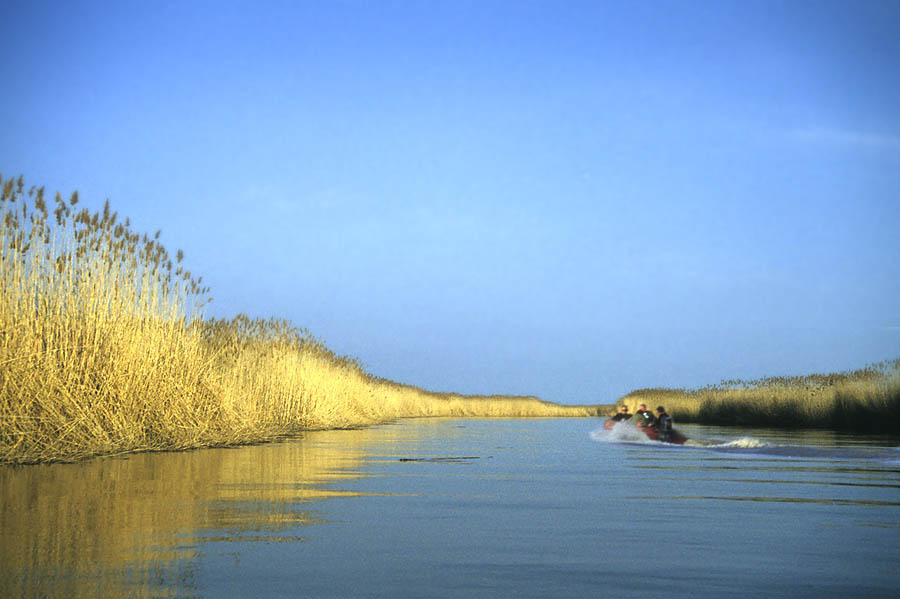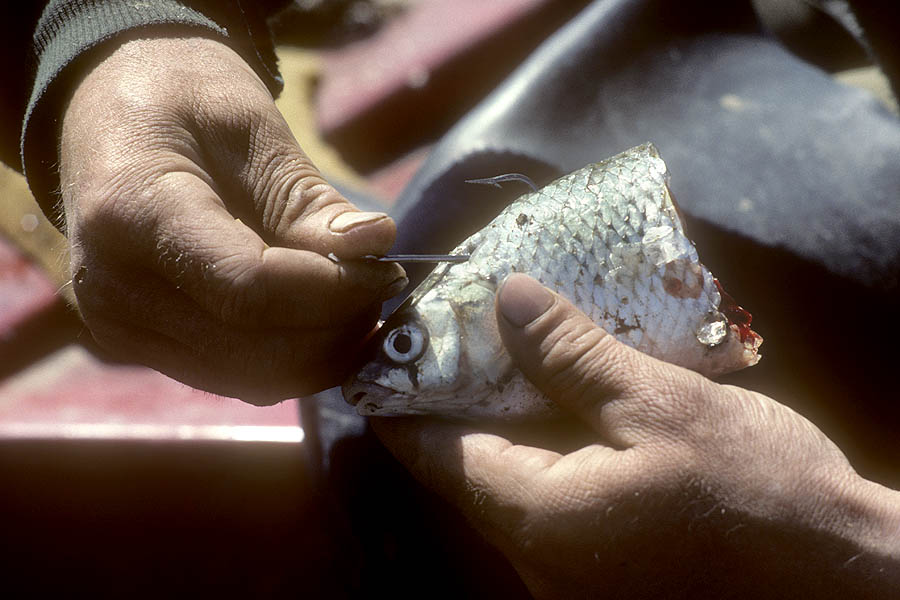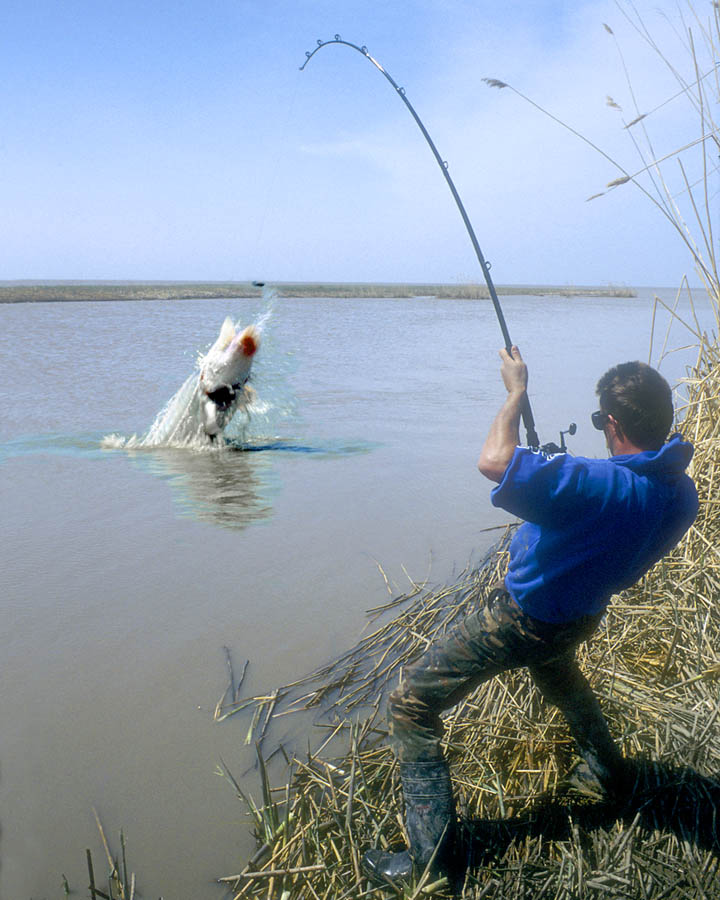 (1993) To me the beluga sturgeon has always seemed a fantasy fish. Until ten years ago it hardly ever appeared in the sports fishing community – there were almost no photographs of these caviar leviathans.
(1993) To me the beluga sturgeon has always seemed a fantasy fish. Until ten years ago it hardly ever appeared in the sports fishing community – there were almost no photographs of these caviar leviathans.
Of course, the fish was known for its expensive caviar, but it was only in the beginning of the 1990's, when the stiff communist system started to mellow up, that the beluga sturgeon was made available to anglers.
The beluga sturgeon, or house sturgeon, is difficult categorize as either salt- or freshwater fish. It spends most of its life in the huge inland sea, the Caspian Sea, which is brackish to salt, and runs up the big rivers to spawn.
The beluga doesn't have teeth, but lives solely as a predator – and, man, can it consume some fish. The biggest beluga sturgeon ever to be registered, was caught by local industrial fishermen. It weighed 5.500 lbs, and it was close to 6 metres long.
The IGFA all-tackle record is no more than 232 lbs, so, needless to say, the record doesn't really reflect the actual potential of this monster fish. Many fish, much bigger than the record, are caught every year.
In 1993 I got the chance to do battle with these monsters myself. The previous years reports said, that the Ural River was almost paved with spawning sturgeon in the month of April.
I tend to take such information with a little scepticism – too many times I have heard "over-positive" fishing reports – but this time I have to admit, that it was all very true.
The first we saw of the beluga sturgeon were their lumpy grey backs, breaking the surface of the cocoa coloured water of the Ural River – and there were fish everywhere!
The sturgeon cruised like sharks in search of prey in the river delta, using their highly sensitive barbels and sidelines to locate the smaller fish.
 All of a sudden the water erupts, as if somebody has thrown half a ton of lively fish into the river – a shoal of sturgeon have managed to drive thousands of smaller fish up against the reeds, and as if on cue the belugas charge the prey – it virtually sounded like an explosion.
All of a sudden the water erupts, as if somebody has thrown half a ton of lively fish into the river – a shoal of sturgeon have managed to drive thousands of smaller fish up against the reeds, and as if on cue the belugas charge the prey – it virtually sounded like an explosion.
The next sounds you hear are the huge mouths sucking – and I mean super-sucking – the prey fish in. This actually sounded like flushing a particularly big toilet …
To testify that there were many sturgeon, I have to tell you, that our small boats were literally torpedoed by the huge nearsighted fish, and driving the boats into the smaller side channels of the river delta, we had to go on very low power in order not to get sunk by the big beasts.
We totally fished our butts off. We were really fighting almost all day long. Not to say, that we landed all the fish, because many fish were lost. The trick was to keep them from picking up too much speed, and try and turn them around before they reached the Caspian Sea.
Most of the fish were fought and landed within 15 minutes, but some really gave everything, and these fights usually lasted 2 to 3 hours. Imagine our arms at the end of the day – boiled spaghetti …
I have fished many places in the world, and I have fought and caught big fish before, but all that didn't prepare me for what I had in store in the afternoon of our fourth day of the trip.
After a good long fight of almost 2 hours, which resulted in a nice big fish of 90 kg (200 lbs), I recast and hooked another fish straight away. This fish didn't initially feel very big, so I relaxed a little bit, letting it do whatever it wanted to do; and that was a major mistake …
Suddenly the sturgeon charged toward the Caspian Sea, and its back broke the water as it crossed the shallow water of the river mouth. Man, what a fish – it writhed like crocodile colouring the water even more as it thrust over the mud bar, partly free of the water. It was absolutely huge.
 There was no chance of fighting the fish from the river, so we powered the foul smelling Russian boat engine up, and followed the fish as it headed in the general direction of Iraq. During the next couple of hours I made no impression on the fish, whatsoever. It didn't want to come closer than about 100 yards of the boat, no matter how much I struggled.
There was no chance of fighting the fish from the river, so we powered the foul smelling Russian boat engine up, and followed the fish as it headed in the general direction of Iraq. During the next couple of hours I made no impression on the fish, whatsoever. It didn't want to come closer than about 100 yards of the boat, no matter how much I struggled.
Getting closer to sunset, we started to get a little worried about the whole situation. We were a good mile out in the Caspian Sea, and our guide let us in no doubt about the difficulties of trying to enter, let alone find, the river mouth in the dark. I honestly put every last bit of energy into pumping the fish closer to the boat, in the vain hope of catching this monster. Vain, because I didn't know what our guide, Pasha, had in mind
At last the fish gave in – a little, anyway. At about 10 yards from the boat we finally got a good look at the immense fish. It was well over 4 metres long –longer than our boat. I started to get my hopes up, feeling that the end of the fight was near. Well, the fight ended all right, but certainly not the way I had visualised.
With a quick move of his hand, Pasha cut the line and gave me a great big smile. I can't express my feelings at that moment, except for total and utter devastation. Pasha realised from my facial expression, that I needed an explanation very quick. He explained in faltering English, that we would have had absolutely no chance of landing or bringing the fish to shore. Both the time involved, which would put us in total darkness, and the immense fish, that could easily turn the boat over. In retrospect, I have to agree with his decision, but what a disappointment to let that beast go.
When we were safely in the river delta we asked Pasha about the estimated weight of the fish, and as he usually did, he wrote with a wet finger on the boat side 800 – meaning 800 kg (1760 lbs).
I have to emphasize that the guides were never more than a few kilos off "guestimating" the fish – we know that because we weighed the biggest fish.
The last day I managed to land the biggest beluga sturgeon of the trip: 152 kg (335 lbs) – 3 metres in length. We were 8 fishermen, and all in all, we landed a grand total of 110 sturgeon, with an average of 80 kg (175 lbs), and with 20 over 90 kg (200 lbs). The majority of the sturgeon were beluga or house sturgeon (Huso huso), but some were the less known schipp or fringebarbel sturgeon (Acipenser nudiventris), and sevruga or starry sturgeon (Acipenser stellatus).
 During the trip we tried the famed beluga caviar several times, and I must admit that the freshly marinated caviar tasted absolutely delicious.
During the trip we tried the famed beluga caviar several times, and I must admit that the freshly marinated caviar tasted absolutely delicious.
The fishing gear we used was stand-up biggame rods 30-50 lbs, and Ambassadeur 9000C reels with 0.60 abrasion resistant line. We used a 2 metre leader of 1.00 mm nylon line to take the worst of the abrasion from the sturgeon's sandpaper skin, and size 5/0 to 8/0 Gamakatsu single hooks. The best bait was undoubtedly a half asp (Aspius aspius), or a half roach (Rutilus rutilus).
When we arrived at Copenhagen Airport, we went straight to the Finefoods Shop, where we checked out the caviar prices. At that time, the beluga caviar cost the eqv. of 100,- UK £ per 100 gram. Our guides let us know, that a third of the weight of the female beluga sturgeon is caviar, and assuming that half of the sturgeon we caught were females, we calculated that we had caught close to a million UK £ worth of fish eggs.
Na Starovia !
